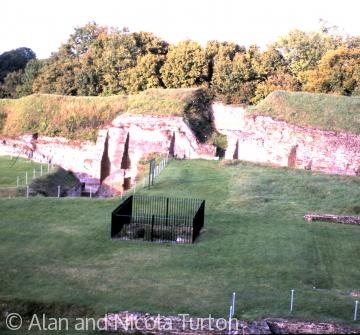Basing House, Old Basing

Standing on a hill above the marshy valley of the Loddon, Basing House has long been the site of human habitation. Iron Age and Roman remains have been found beneath the earthworks which still dominate the monument. These were thrown up sometime in the mid 12th century by the de Port family, to form a huge timber ring-work castle now known as the "Old House", with at least two baileys. Hugh de Port had been granted the manor of Basing by William 1st shortly after the Conquest and his descendants held it until 1972 albeit with changes through marriage to the family name – first to St John, then Poyning and finally in 1420 to Paulet.
By 1525 Basing was owned by Sir William Paulet, a statesman of outstanding skill and the ability to survive the storms of Tudor court life, dying in bed in 1572 at the age, some claim, of 100 years, as Lord Treasurer of England, and Marquess of Winchester. During his long life, Sir William rebuilt the house twice, the first time in the 1530s having obtained a ‘Licence to Crenellate’ from the crown and secondly in the 1550/60s when he massively enlarged his home by the construction of the ‘New House’. Most of these structures were of local brick with fine white stone mouldings and decorations of the finest craftsmanship. Sir William was no stranger to playing host to huge royal progresses which included Henry VIII, Edward VI, Mary and Philip and Elizabeth I, all at vast cost, which his descendants found crippling to continue.
Following the visit of James I in 1603 the decision was taken to demolish part of the house. The Paulet family withdrew to make a home in the estate's hunting lodge at Hackwood, and by 1635 Basing House was described as ‘forsaken and desolate’.
In the Civil War the Catholic John Paulet, 5th Marquess of Winchester, declared his support for King Charles I and returned to Basing to refortify his ancestral home and turn it into a royalist garrison. Large scale earthwork defences were thrown up around the house and the Tudor brick curtain walls were loop holed for muskets and artillery. The Marquess and his 300 or so men managed to hold the garrison through sieges in 1643 and 1644 but finally the house fell on 14 October 1645 to Oliver Cromwell at the head of a brigade of over 7,000 soldiers. The house was gutted by fire during the assault and shortly afterwards Parliament gave order that the ruins could be used as a free quarry. The villagers of Basing lost no time in repairing their war ravaged homes with salvaged material from the once mighty Tudor palace.
Following the Restoration in 1660 John Paulet was given the site back but it was not until the 1670s that his son and heir Charles 6th Marquess of Winchester, later 1st Duke of Bolton, began to show interest in it. Charles demolished most of the ruins and laid out the site as an elaborate landscape garden with a vineyard to form a view for a new hunting lodge he constructed in the Grange Field next to the Great Barn, the only major survivor of William Paulet's great building complex.
By the middle of the 18th century, the Duke's hunting lodge had been demolished and the new gardens overgrown and forgotten. In the 1790s the Basingstoke Canal was driven through the site of the New House and a bridge constructed just inside the surviving Garrison Gate. Like the Duke's hunting lodge, the canal was short lived due to the coming of the London and Southampton railway in 1839 and problems with a dependable water supply.
In the 1870s Lord Bolton, owner of Basing House and direct descendant of William Paulet began a series of excavations on site which were to last for 40 years, and revealed much of the plan of the lost house. A great many small finds were discovered which Lord Bolton housed in a purpose built museum (the Bothy).
During the 2nd World War Basing House served as the site for an anti-aircraft battery and a training ground for the local Home Guard. In the 1960s excavations were carried out on various parts of the site and in 1972 the historic monument was purchased by Hampshire County Council.
UPDATE:
The University of Southampton are carrying out excavations at Basing House. Follow them on Facebook or on the Project blog
Content derived from research undertaken as part of the Victoria County History project








